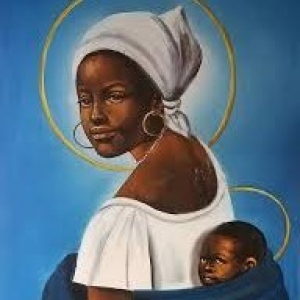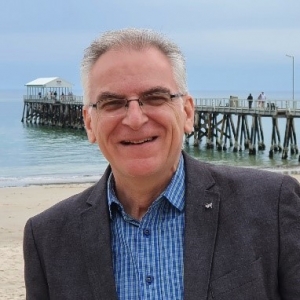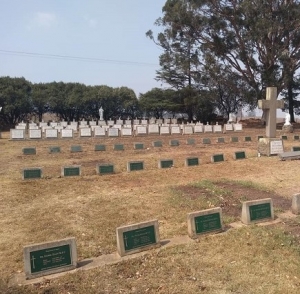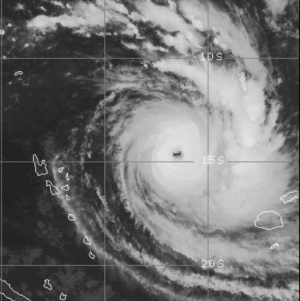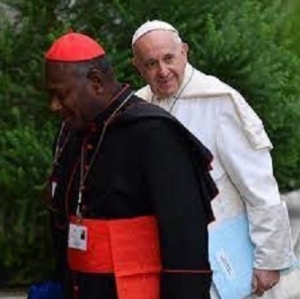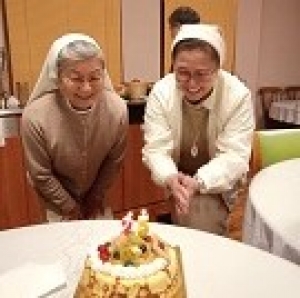Peter MALONE
Christmas greetings and blessings for our visitors.
Christmas greetings and blessings for our visitors.
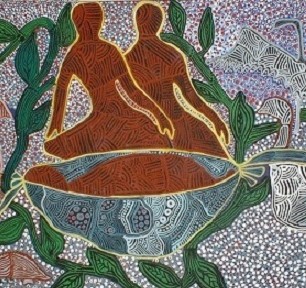
A Bethlehem painting by Suzanne Nurra.
A reflection (excerpt from Andy Hamilton SJ, Eureka Street)
The images and language of Christmas have grown particularly weary. As it has become a public rather than a religious celebration, the words associated with it have been commodified to sell food and drink, all kinds of trinkets as presents, and a generalised bonhomie as the appropriate mood. Even the cards that put Christ back into Christmas make the manger a nice place, remove the dirt and smells that go with cattle, shepherds, camel travellers and two young people seeking shelter after a long journey. For people who do it hard, the language, the gift-giving and the feasting cannot but remind them of their exclusion.
If we want to renew religious language and images we must begin with attention to the words we currently use, noticing their resonance as well as their meaning. It is then important for the language of prayer and reflection to be grounded in deep contemporary experience.
In the Christmas stories, for example, we need to pay attention to the experience of people who have a similar position in our society — to find equivalents to the young people desperate for a room in which decently to bear a child, to the shepherds regarded as marginal and irreligious by a religious society, to Herod’s soldiers free to intimidate, to rob and to kill, and to a grotty field on the edge of town.
In prayer, too, we need to find words that encompass the desperation, rage, terror and passion that need healing and acceptance. Finally, if our words are to open to us another world beyond that of our daily routine, they must be evocative, finding intimations of immortality in the mortality that they touch.
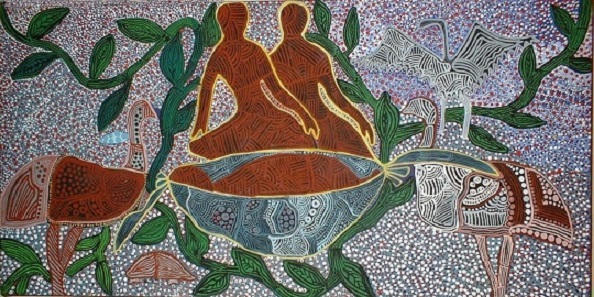
Some end of year good news from MSC around the world
Some end of year good news from MSC around the world
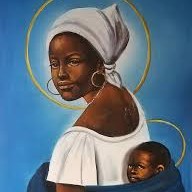
Ordinations Africa
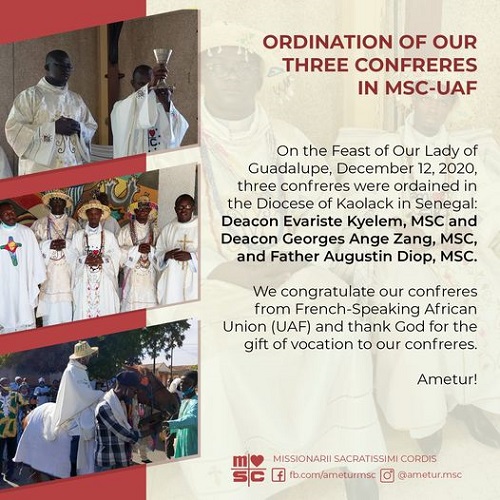
Profession. Asia
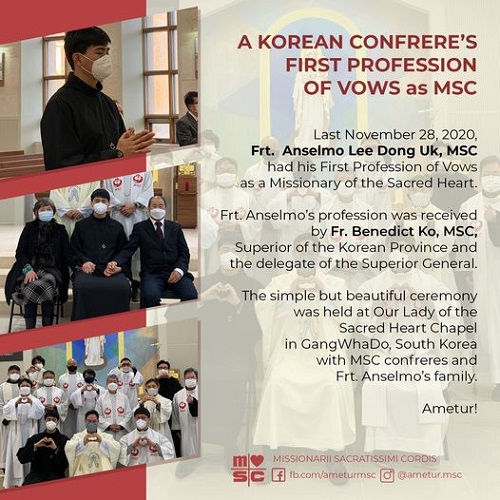
And our novices in the Philippines, Filipinos and Vietnamese
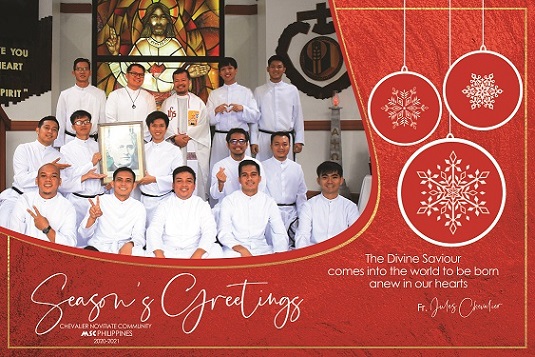
And from the PNG Mission Office

FROM THE PROVINCIAL’S DESK - Christmas Summer 2020/21
FROM THE PROVINCIAL’S DESK - Christmas Summer 2020/21

At last Christmas is here... and then we’ll begin again - a New Year - 2021!
But what a year? What – a – year!
What a year it has been. What has it been for you, for us, and for God’s mission? Maybe now as we come to the end of one of the worst years in history – what has this year meant to us, to me – what then has the Christmas message have for us in a Covid19 period?

A couple of years ago I was told of a story of a woman who worked in an office in North Sydney, and of how she got really excited about the Christmas period. She would come into the office on the last weekend of November and decorate it all, beginning with a Christmas tree, tinsel on all the walls, presents under the tree, Christmas lollies placed strategically around the office and even down to a Nativity scene. It had the lot.
Another woman in the office asked her on the Monday morning, why she got so excited about the lead up to Christmas. Her reply was: “Well, this is the best part of Christmas for me… [and with a lump in her throat] because Christmas day is the loneliest day of the year.”
Christmas time for many is a really hard time of year.
For some it brings up the loss of family members; for others it opens old wounds and scars from past events. For some people Christmas can be a violent time or an extremely lonely time. Today, as I write this introduction to our magazine, I ask myself what will it be like this year, with so many working from home due to Covid19, isolated and lonely?
So, what does Christmas really mean?
What does it mean when we say: Today is born a saviour, Christ the Lord?
How did Christmas go from what it was originally – a story of alienation, political tyranny, homelessness, working-class people, pagans, and angels – to Santa Claus, wonderful Christmas trees, sentimental Christmas songs, and beautiful nativity scenes… all of which I like.

Over the four weeks of Advent we light the Advent Candles – all of which, in most places, are on stands, up high for all to see… and then, come Christmas Eve, we place the child Jesus at floor level. It is a movement of coming down. Entering in at the bottom.
But this not the world we live in today. We live in a world which is about climbing up, to be on top. Like the Trumps, the Murdochs, Rineharts, Palmers, corporate leaders, as well as many of our political leaders, left and right, and I could go on and on, of this world… and, maybe, when in my 20’s, I thought this is what life is really all about… climbing to the top.
But on Christmas night, here is our God doing the opposite, our God comes down the ladder. Yes, on the one hand we praise and sing “Glory to God in the highest”; he is our God-hero who has come to save us. But on the other, here is our God, the God-hero, who is an infant, a baby, small, helpless, fragile, and is placed into the hands of others who will take care of him.
Here, Jesus is born in a stable, among the animals; let us picture this scene: Here is the new born child, Jesus, here he is among the animals, the straw, the smell, the manure and a lot of other things… think about this… imagine it if you can… smell it… breathe it in… here is our God, born into a smelly, stinking place – this is our God – this is our saviour!
Who of us would have ever thought of this as an image of God… no one! Not only is he born into the mess and smell of a stable, but he is also born into a despised race, who are also occupied by a foreign country. He is at the bottom!

THIS MUST HAVE MEANING FOR US
For me, this story is about God meeting us in the mess. In my mess. In our mess. In this Pandemic Covid19 mess. In the smell and stench of the stable of our lives our God meets us – meets us where we are. Where we are most helpless – where we are most powerless – our God meets us.
It is about our God coming into our loneliness, our pain, our poverty, our vulnerability, our helplessness, and meeting us where we are at.
This is HOPE.
So many other great religious traditions try to move us beyond the human experience: for the Hindu – it is Nirvana; the Buddhist – it is enlightenment; the Jew – it is heaven; and we could go on, but for us, our God meets us in our humanness… in our body… in our here and now. Our weaknesses, our failures, in our nakedness, in our times of loneliness, in the midst of family breakdown, in our addictions, in our poverty – our God meets us.
Not only this, but our God also meets us in our togetherness, in our moments of joy, our moments of fun, in all our good times - our God meets us.
A lot of us fear ‘this reality’, that we meet our God in our humanity, in our togetherness. In fact the Christian story assures us that we do not have to leave the world, we do not need to enter into nirvana, enlightenment, or even heaven to meet God, for our God comes to us – Emmanuel: God–with–us.
As we experienced this terrible year of Covid19 - one cannot hide from the pain of the world. One cannot cover it up. All we can do is share it – God did.
God left whatever throne people had put him on in their imaginations and came to earth. God walked down the ladder, letting go of being powerful and mighty. This is who OUR God is: a baby, fragile and helpless, the one who shares our poverty, our helplessness, our powerlessness; the one who enters our very human, lived condition and shows us the way of hope.
This Christmas, and hopefully a post-Covid19 New Year, let us walk down that ladder, let’s let go, and discover where we least expect to find God, in our own very lived, human, messy condition. And from this place we can then sing: “Glory to God in the highest and peace to all of goodwill.
Have a very peaceful, joy-filled Christmas and we look forward to 2021 to continue God’s mission – being on earth the heart of God.

Finally a really big thank you to our Deputy Provincial, over the past three years, Stephen Dives msc. Steve has not only been a wise council to me over this period, but a wonderful friend, who has been supportive, encouraging, and showing great brotherly love. Thankyou Stephen. I wish you every success and blessing as you take up this new chapter of being Superior of Sacred Heart Campus, Kensington. Thank you!
Cheers! your brother MSC,
Chris
Remembering Austin Sheridan MSC, John Northey MSC. RIP on the 50th anniversaries of their deaths.
Remembering Austin Sheridan MSC, John Northey MSC. RIP on the 50th anniversaries of their deaths.
50th anniversaries, Golden jubilees, offer an occasion for remembrance and some thanksgiving.
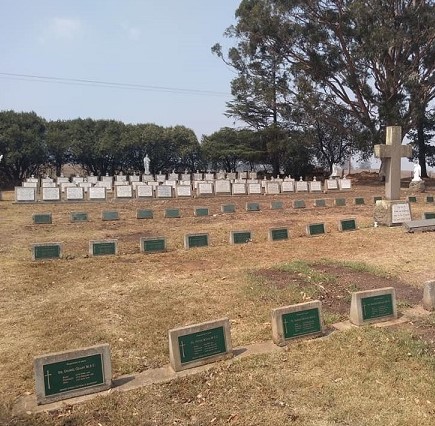
Some of us remember the occasions themselves – and would like to hand on to those younger some memories.
December sees the 50th anniversaries of the deaths of two of our MSC conferences, John Northey and Austin Sheridan. They both died after long-term cancer.
The editor of the website remembers both.
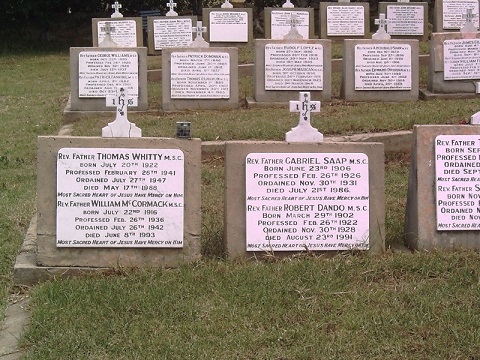
In 1952, Austin Sheridan was teaching at Chevalier College and in charge of the junior dormitory. He was very earnest. He was a good maths teacher – especially using the device of promising to read one of GK Chesterton’s Fr. Brown stories each time we finished a section of the textbook. (And, on the night of the Old Boys Reunion dance, in the hall near the dormitory, he drowned out some of the music and revelry by reading us excerpts from Miss Pross and Mme Defarge in A Tale of Two Cities.
The end of the year, he was transferred to Hindmarsh Parish. We encountered him again in 1957 at Douglas Park during the novitiate, with choir work.
In the last years of his life, he was transferred to Papua New Guinea, a lifelong desire. However, his cancer became very severe – and I have a special memory of visiting him at his mother’s home in 1970. Always very thin, he looked emaciated, in great pain, having to lie on a mattress on the floor for some ease. He died on December 4, 1970, aged 50.
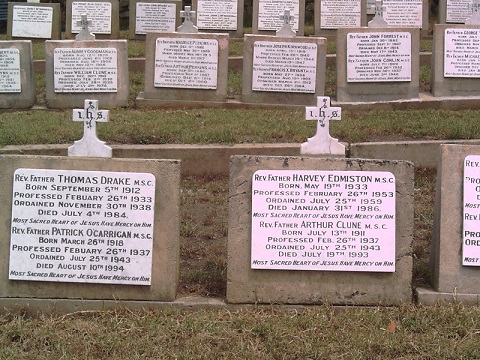
Those who remember John Northey realise that he looked the opposite of Austin Sheridan. He was big. He was tall. And he had a booming presence. He was well educated, a great reader, chaplain to the drama Society in Adelaide, the Therry Society, a man of wide culture.
When he was diagnosed with terminal cancer, he moved, in 1968, to work with Fr. John McMahon as provincial secretary. His previous appointment had been at Daramalan College, Canberra, where he was an intimidating presence. James Bond in Thunderball had been released and the boys called Fr Northey “Thunderguts Guts”. You could hear him roar, “You will obey me” from nearby buildings. His method of objecting to an adjacent class’s noise quotient was to get his class to count from one to ten getting louder and louder (and sending back the boy who came to request quiet on behalf of his teacher with a six).
When some of us went to see films in 1966 and 1967, he referred to us as “ecclesiastical Peeping Toms” and reported us to the provincial many times. However, a personal testimony: when Paul Stenhouse took him to a press preview in 1968, a provocative film and he stayed till the end, I asked him whether I should review it in Annals. He gave me the reassuring and supportive reply, “you should review all controversial films in Annals”. That was in 1968. He died on Boxing Day, 1970 – and, when going to the hospital after his death, he looked very much asleep, at rest, except for his hands, sallow and dead.
Many will have their own memories of Austin and John. They are part of the heritage of the MSC Australian province.
Solidarity for Fiji, for the MSC Pacific Union. Cyclone Yasa
Solidarity for Fiji, for the MSC Pacific Union. Cyclone Yasa
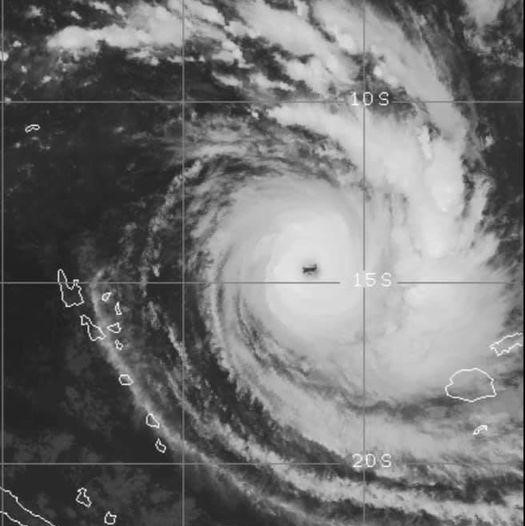
Severe Tropical Cyclone Yasa was the strongest tropical cyclone in the South Pacific since Winston in 2016 as well as the fourth most intense tropical cyclone on record in the basin. The system was the second tropical disturbance, as well as, the first named storm and severe tropical cyclone of the 2020–21 South Pacific cyclone season.
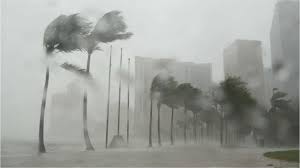
Yasa maintained its intensity and became more defined on satellite imagery as it bore down on Fiji. An address was sent to the entire country from the nation's Prime Minister Frank Bainimarama regarding preparations for the storm. Shipping services were halted, and fishermen were advised to not go out into sea, due to fears of Yasa possibly injuring or killing them. Multiple warnings were issued, including heavy rain, heavy wind, and flood warnings. Soon, the entirety of Fiji was under warnings as Yasa neared.

The impacts felt from Yasa were large and wide. Impacted areas have lost all communication. Transportation was hampered as 72 roads in the country were closed due to fallen trees, powerlines, and flooding. Heavy rain was recorded for most of the country. Damage is still being assessed as the storm leaves Fiji.

Donations can be made to the MSC Mission Office.
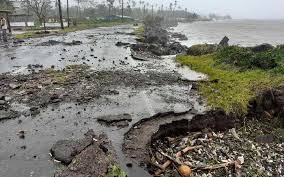
Looking back on 2020 with a smile
Looking back on 2020 with a smile
It has been a hard year with coronavirus, infections, deaths, the pressures of lockdown - and uncertainty about new waves and future waves. So some moments of the gift of humour and mirth.
The prospect of Christmas

A variation on the theme

Staying Biblical

2020 masks

And lockdown
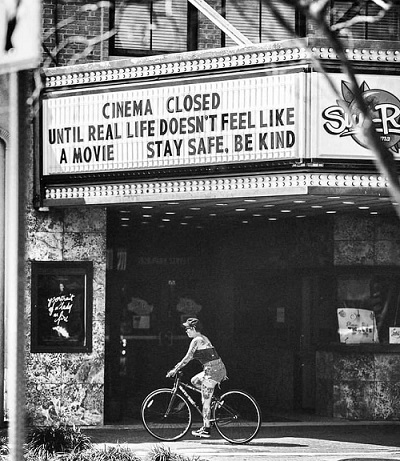
PS

The Spanish Flu – and the Making of a True Hero. A Catholic issue, anointing. An OLSH Randwick connection.
The Spanish Flu – and the Making of a True Hero.
A Catholic issue, anointing. An OLSH Randwick connection.
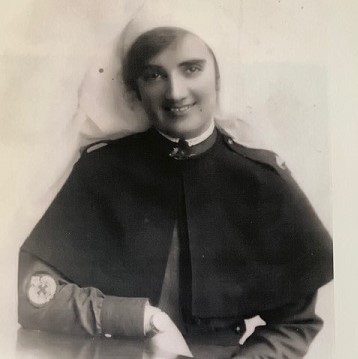
In our pandemic 2020, we go back to the experiences of the Spanish Flu a century ago. With thanks to the editors OLSH Randwick Bulletin.
The Spanish Flu, known as the Great 1919 Flu, saw thousands of returning World War 1 soldiers confined to the North Head Quarantine Station. And it was there that Annie Egan was to become a national hero.
Annie Egan was born in 1891 in Gundagai, New South Wales, the fifth daughter of nine children, two boys and seven girls, three eldest of whom became Sisters of Mercy. Annie went to school at St Mary’s College Gunnedah and began training as a nurse at St Vincent’s Hospital in 1915.
In the dying days of the war troops ships began returning to Sydney and bringing with them the dreaded Spanish Flu. Hundreds of infected soldiers were placed in the Quarantine Station at North Head and it was there that Annie, having passed her Nurses examination in 1918 volunteered to become a Military Nurse. She was soon to contract the dreaded flu and within months she was to die.
And it was with her death that she was to become a hero in circumstances of a bitter sectarian war and clashes with Commonwealth authorities.
The circumstances? There had been a number of priests stationed at the Quarantine Station but over time their numbers had dwindled and when Annie became ill there were none there. No replacements were allowed despite pleas to various Commonwealth Authorities by the Archbishop of Sydney, Michael Kelly.
And by late November 1918 Annie, then with the effects of the disease, realised that death was imminent and requested that a priest hear her confession and administer her the Last Rites. The Government denied her request. A local priest at Manly had offered to visit Annie but that request too was denied. Archbishop Kelly threatened to enter the Station but that request too was denied.
Annie died on 3 December 1918. A wave of protests followed Annie’s death, not just from Catholics but from citizens generally aghast at the denial to Annie of her request for the Last Rites.
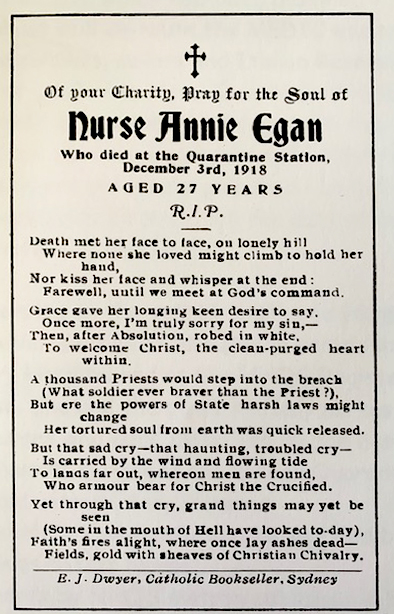
At the Requiem Mass on 6 December with her grief-stricken parents in attendance at St Mary’s Cathedral, the Archbishop berated authorities and said ‘Let it be remembered that Nurse Egan has won the martyr's crown. They have given her military honours at her funeral. As if she had no soul. As if that were enough. They might lay a Victoria Cross or any other decoration upon her tomb, but they nevertheless denied her dying wish to have her God in the Holy Viaticum.
Fr John O’Gorman, Administrator, St Mary’s Cathedral wrote to Annie’s mother following the funeral to say Though your daughter has lost her life you should feel very proud of her bravery and fidelity. She died with prayers on her lips and sorrow and love in her heart. But besides her death awoke Australia to the consciousness of Pagan officialdom and given it a blow from which it will not soon recover. Her death in such (circumstances/ certainly) will make for religious liberty in quarters where it is more needed than people think.
AND THERE IS AN OLSH RANDWICK CONNECTION both past and present. Bill and Noeline Egan were long time parishioners of OLSH and St Margaret Mary’s who passed away in 2007 and 2008. Some older parishioners may recall them and may even know that Annie was Bill’s Aunt. And Bill’s daughter Catherine and her husband Martin Hoe and children Alison and Jennifer are members of a number of our parish choirs. Importantly the family have a treasure trove of letters written about her on her death.
From her friend Lauren writing to Annie’s sister Kate after her funeral (Annie was also known as Burns – her mother’s maiden name)
The Italians had made a huge harp about 5ft high with wild flowers which they gathered themselves & two of them carried it behind the gun-carriage all the way up to the cemetery. It was so good of them and they had Annie’s name in flannel daisies in the centre and the Italian flag at the head. Everyone here loved Burns – the men were continually asking about her and they all said how cheerful and bright she was and so willing. She has left a wonderful record dear and will never be forgotten. The cemetery is right on the point of the Head and overlooks the Harbour to the ocean outside.
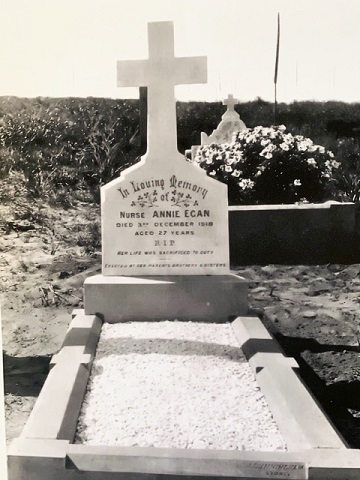
From Fr Daniel Keane the Parish Priest of St Joseph’s Church Gunnedah
Now whenever any difficulties are placed between the sick and their priests, Remember Nurse Egan! Her name resounds through the whole country as a synonym of deep, sincere, religious and patriotic culture. We continually hear people parading their patriotism for their own private ends. But her action has given a noble lead in this virtue, so much extolled in people but so little practised.
And the story recounted by Lil, Annie’s sister, about a young soldier who approached Annie’s brother Matt (Catherine’s Grandfather) at Central Station as he was returning by train to Gunnedah. The soldier asked if he were Nurse Egan’s brother and immediately shook his hand and apologised, stating that he had been guarding the gate at the Quarantine Station and was very sorry as he had orders not to allow anyone in. That anyone included Archbishop Kelly.
Eight days after Annie’s death and with pressure mounting to change its stance on refusing priests access to the Station, the government agreed to allowing chaplains access to the Station.
In honour of Annie Egan a Memorial Headstone was erected at the Quarantine Station.
References: Egan family; Jeff Kildea -The Australasian Catholic Record; Croppies Downunder. Samantha Elley- Tales from the Grave. Various Trove articles
Daramalan Residence to a Performing Arts Centre.
Daramalan Residence to a Performing Arts Centre.
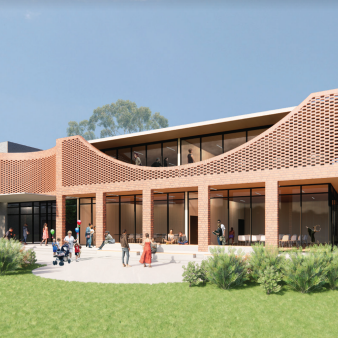
The future.
In1966, the MSC residence was full – 24 brothers and priests living there, plus to more in the flat in the Sharpe wing. Over 55 years and more, a big number of MSC had resided there plus many visitors. End of an era.
As most would know, the old Naughton Wing/Residence is coming down to be replaced with a new Performing Arts Centre.
The new building will comprise a multi-use foyer, performance space, drama and music classrooms, music tuition/practice rooms and a rehearsal space for bands, with the performance space holding about 200 people.
The new building will be sustainable and energy-efficient incorporating rooftop solar and water recycling and is expected to be completed by late 2022 in time for our 60th anniversary.
It was announced at Chevalier Day the Wing will be called the “Issoudun Wing” after the French town where Fr Jules Chevalier started the MSC order in 1854. The name pays honour to the Daramalan priests and brothers who vacated the site last year after living there for the last 57 years
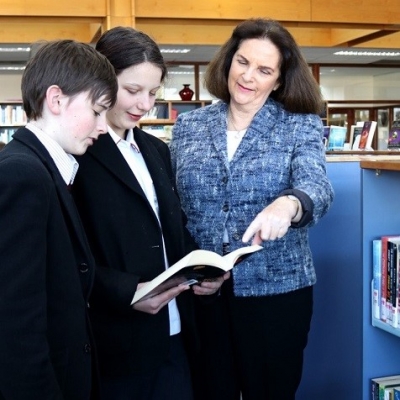
Rita Daniels, outgoing principal, reflects on MSC vision for Australian education.
I have spent more than 32 years working at Daramalan – the last 12 as Principal - so this school covers a very significant proportion of my working life. It has been a wonderful journey – working with many outstanding people who have made a huge impact for good on the lives of thousands of young people by their care, their compassion, and their commitment which have been illustrated in many different ways. While many educational institutions promote themselves as excelling in single things such as academic or sporting achievements, languages or the performing arts, I know that Daramalan College has been, and I am sure will continue to be in the future, a place which welcomes all young people – the talented, the strugglers, the middle of the road students, the lost souls and those needing a great deal of help throughout their school journey. Keeping this school as being a place that welcomes everyone, not just the talented or gifted, at the centre of our thinking and of our work, is critical to us continuing to live out our core values and I take much comfort in knowing this is what we do day by day.
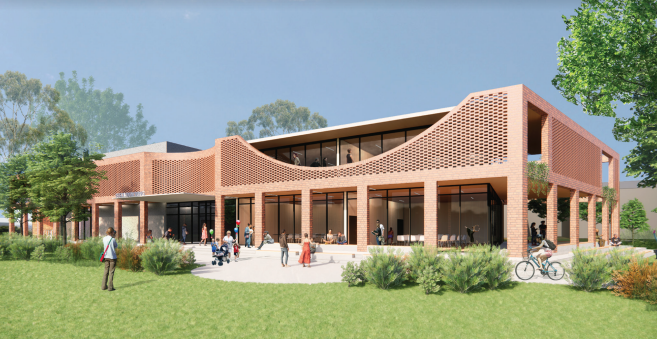
Cardinal John Ribat MSC – interview on his life, commitment and causes
Cardinal John Ribat MSC – interview on his life, commitment and causes

From The Catholic Leader
Cardinal John Ribat: “(Jesus Christ) said; ‘When I was hungry you fed me, when I was sick you came and visited me, and when I was homeless you came for me’. And it is a message we cannot just forget, pretend it is not there.”
A CARDINAL best known for defending Pacific island nations swamped by the impacts of climate change has spoken candidly of another challenge – his own daily commitment to be a priest.
“The question really is how do I live my life in relation to the formation but also the sexuality that is deep within us. How do you live that?” Cardinal John Ribat, president of the Federation of Catholic Bishops’ Conferences of Oceania, said in an interview with The Catholic Leader.
“For me, the thought of having a wife, in life, it will always be there, and a challenge that I have to face until I die.
“And I talk to priests about it, and I work with seminarians as well, and that’s what I talk about.
“How do we see this God-given gift to us? How do we see giving life to others, and building the community and unity that we want to see?”

Praying at the tomb of pioneer missionary bishop, Henry Verius MSC
In 2016, Pope Francis elevated John Ribat, Archbishop of Port Moresby since 2008, to become Papua New Guinea’s first cardinal, an appointment widely seen as an example of the Pontiff reaching out to include leadership voices far from Rome.
In the same year, Cardinal Ribat was honoured with a knighthood – named in the Queen’s Birthday honour list.
Since then, Cardinal Sir John Ribat has publicly focused much of his ministry on addressing climate change, drawing on Pope Francis’ encyclical on the environment Laudato Si’ (On Care for Our Common Home) to advocate for urgent global action to address rising sea levels and predictions of hotter days and more volatile rainy days in PNG and Pacific islands.
Yet, just as important, he said, was the life-affirming personal witness he can offer to strengthen the resolve of seminarians and younger priests.
“The sexuality that we have – we did not choose it. It is a gift to all human beings … we did not choose it, God gave it to us,” Cardinal Ribat said.
“But then how do we use it? In a way that helps us to live our life … joyfully and meaningfully.
“It’s a challenge and each person has to realise it.”
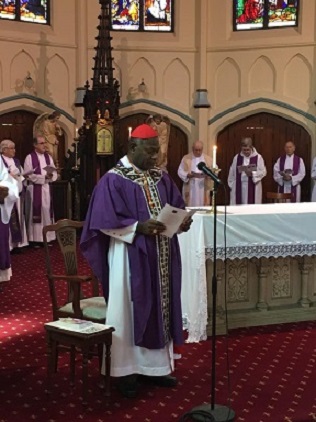
At Kensington Monastery with MSC confreres
In his own, early formation, as a young seminarian Cardinal Ribat said he reached a life-defining crossroad when a former school friend proposed they get married.
His rector told him to take time to reflect and pray about the direction of his life.
“This is deep within your soul – you need to have a partner in life,” Cardinal Ribat said, recalling his thinking at that time.
“This person has prepared for life and now she is looking for a partner … do you follow her now or assume your intention and be that person (a priest) in life?”
He said it became clear to him that God wanted him to prepare “not for this life, but for another life”.
“… The Lord has said this for me, and I have accepted it,” the cardinal said.
“He will always see that this is fulfilled.
“That was the beginning and that was not the last challenge.
“The challenge is … I have to make decisions all the time about where I am with my life in relation to the God-given gift of sexuality in my life.
“It’s not always easy, but if it is Him helping us I believe we’ll find strength to continue to do this until the end.”
Cardinal Ribat has applied this same zeal of faith in addressing even the most difficult issues confronting his ministry.
Laudato Si’ became his guiding document on “how we are shaping the future of our planet”.
“He (Pope Francis) did not address this message only to the Catholic Church, no, it is to humanity because the planet we are living on belongs to all of us and we should work together.
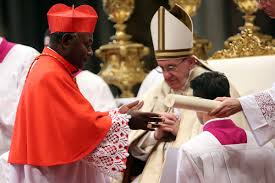
“When I saw that, I said: ‘This is the point’.”
Cardinal Ribat watched with concern as bushfires engulfed Australia’s east coast, and resolved that Australia and Pacific nations must be united in pressing for climate change solutions.
“The rising seas level across the Pacific – we are all affected by this,” he said.
“In Europe and here in Australia you don’t see this affecting the lives of the people.
“But for us coming from many islands – Fiji, Samoa, Tonga, Kiribati, Tuvalu – we are seeing what the sea is doing … washing away good parts of our islands already.
“The first island that has to be evacuated … Carteret Island in Bougainville has been broken into three parts and is really disappearing.
“By 2050 most of the islands will be gone, and that is a great threat to us.
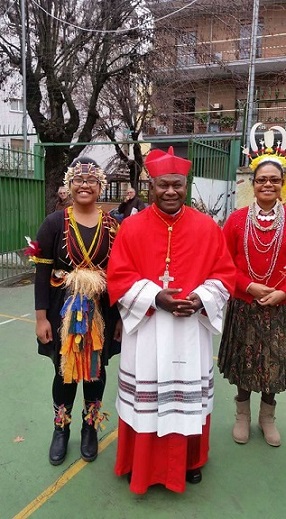
“The work of the Church is to make governments aware that we are responsible for our nation and the common good of our people.”
Similarly, the housing of refugees and asylum seekers on PNG’s Manus Island, and now in Port Moresby is an issue for the Church to help resolve.
“How can we help them (refugees) so they are not affected psychologically?” Cardinal Ribat said.
“It is really an issue that challenges our nation and our people.
“And of course we have our own refugees coming across (the border) from West Papua.
“We realise it is not an issue just for us but for the whole world where people are moving, and their movement is because of something that has happened in their country and has caused them to move out.
“This always reminds me of the voice of Christ – how he challenges us.
“He said; ‘When I was hungry you fed me, when I was sick you came and visited me, and when I was homeless you came for me’.
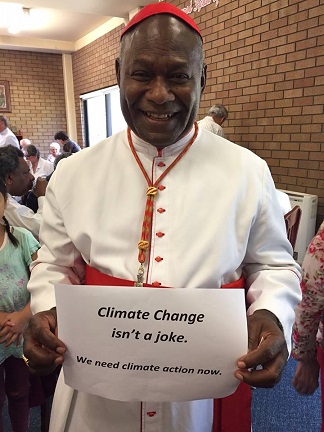
“And it is a message we cannot just forget, pretend it is not there.”
Cardinal Ribat said a great strength in PNG can be seen when Catholic and Protestant churches work closely together, to “journey with the people” and help the government solve national crises.
“We always want the message for all the churches to be united,” he said.
“(In the past) one of the issues that brought us together was the HIV/AIDS. I was there when we launched an ecumenical movement to address AIDS.
“Now the issue is refugees. Our aim is to be ‘one voice’ and in this way we pull the churches together.”
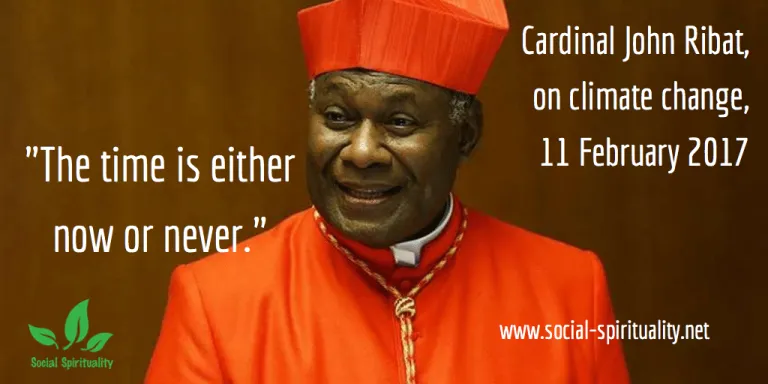
OLSH and MSC in Japan
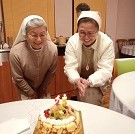
On December 8th, the OLSH Sisters celebrated the Silver Jubilee of their Foundation in Japan.

Amongst the pioneers was Mary Fyfe, later to become Superior General.
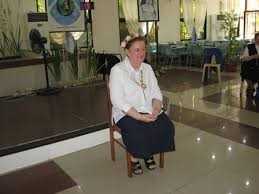
The MSC foundation dates from the post World War II years. Fr Archie Bryson MSC had been a military chaplain (and quite a presence in Japan – and everywhere), Harry Reid MSC was commissioned to establish a mission presence in Japan He was joined by young, but experienced in Rabaul, missionaries, John Askew and Frank Quirk.

For many years, MSC going to Japan were from the Australian province. In more recent decades, MSC have come from the Philippines, Indonesia, India. There are three Australian MSC still in Japan, Brian Taylor, Keith Humphries, John Graham.


